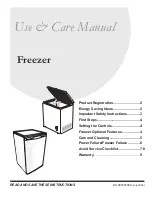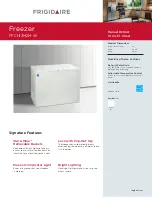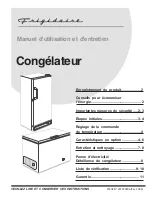
DEFROSTING
A) FRIDGE COMPARTMENT
The fridge compartment defrosts
automatically. The defrosting water runs
to the drain tube via a collection
container at the back of the appliance (1).
(see diagram)
During defrosting water droplets may form
at the back of the fridge compartment
where concealed evaporator is located.
Some droplets may remain on the liner and
refreeze when defrosting is completed. Do
not use pointed or sharp edged objects such as knives, forks to remove the droplets
which have frozen.
If at any time the defrost water does not drain from the collection channel, check
to ensure that no food particles have blocked the drain tube. The drain tube can
be cleared by pushing the special plastic plunger provided down the drain tube
(2). If the frost layer reaches about 1/4"(7 mm), reduce the setting (i.e. from 4 to
1) to restart automatic defrosting.
B) FREEZER COMPARTMENT
The freezer compartment defrosts automatically.
CLEANING AND CARE
** We recommend that you switch off the appliance at the socket outlet and pull
out the mains plug before cleaning.
** Never use any sharp abrasive instrument, soap, household cleaner, detergent
and wax polish for cleaning.
** Use luke warm water to clean the cabinet of the appliance and wipe it dry.
** Use a damp cloth wrung out in a solution of one teaspoon of bicarbonate of
soda to one pint of water to clean the interior and wipe it dry.
** Make sure that no water enters the lamp housing.
** If the appliance is not going to be used for a long period of time switch it off,
remove all food, clean it and leave the door ajar.
** Any dust that gathers on the condenser, which is located at the back of the
appliance, should be removed once a year with a vacuum cleaner.
** Check door seals regularly to ensure they are clean and free from food
particles.
** Removal of door tray
• To remove door racks, remove all the contents and then simply push the
door rack upwards from the base.
** To remove a freezer drawer, pull it as far as possible, and then tilt it upwards,
and then pull it out completely.
** To remove the freezer flap door, first open the door 3” and then gently pull it
off. Make sure that the flap is in place before closing the freezer door.
** Avoid spillage of food particularly small items like rice, peas, beans through the
fan guard as they may cause the cooling system to block and therefore operate
less efficiently.
15
16
Warnings!
The fan inside the freezer compartment circulates cold air.
Never insert
any object through the guard. Do not allow children to play with
the freezer fan.
Never store products that contain inflammable propellant gas
(eg dispensers, spray cans etc.) or explosive substances.
Don’t cover the shelves with any protective materials, which may obstruct
air circulation.
Do not allow children to play with the appliance or tamper with the controls.
Do not obstruct the freezer fan guard to ensure that you
obtain the best possible performance from your appliance.
(1)
(2)
STAINLESS STEEL DOOR CLEANING INSTRUCTIONS [ONLY VALID FOR
STAINLESS STEEL MODELS WHICH HAVE “X” SUFFIX IN THE MODEL NUMBER]
Stainless steel surfaces of your appliance require special cleaning methods. In
order to eliminate marks on doors and to keep your appliance doors clean,
we recommend you the following to clean and wipe the stainless steel surfaces
of doors:
1.
You can purchase special cleaning materials suitable for stainless steel
surfaces of kitchen appliances from your local store. Follow the instructions
supplied by the manufacturer of such cleaning materials.
2.
You can purchase a special micro-fibre cleaning cloth pack called “E-cloth”
from your local electrical or hardware store, which is suitable to clean and
wipe stainless steel surfaces of kitchen appliances without the need to use any
chemicals or other cleaning materials. You just need warm water. You need to
follow the instructions supplied inside the packaging of E-cloth.
Drain Tube
Defrost
Water
Collection
Freezer fan






























